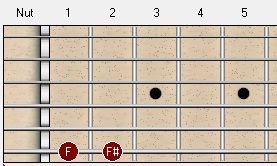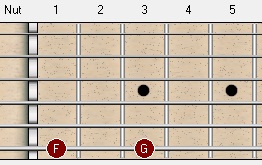
Learn the fretboard + music theory!
Hello and thanks for joining me again!
Today I want to discuss learning the natural notes found on the thick E (by now you know the guitar has 2 E strings…I hope) and the A strings of the guitar.
There are patterns on the guitar fretboard and we can analyze these patterns using what are called half steps and whole steps and this will help us learn the fretboard note names a little easier if we can recognize these patterns.
A half step on a guitar fretboard is when two notes are right next to each other ie. fret 1 to fret 2 (see diagram 1)
and a whole step is when there is a note in between ie fret 1 to fret 3 (see diagram 2).
Okay so what we mean by natural is, the notes are going to be plain letters, none of this A#, Bb stuff…yet.
The natural notes we want to learn are as follows:
A B C D E F G
Yep, only 7 to start with. Why these 7? Well, once you learn these 7 notes
up and down the fretboard, it is an easy task to raise a note one fret, say C to C# or to lower a note 1 fret say B to Bb.
The reason we want to learn the notes on the large E and A string first is because most beginner type movable barre chords and most scales as well have their roots (name of chord/scale) based on these strings.
So have a look at diagram 3 (click to enlarge):
What you want to do is, start on the large E and name the notes all the way up the fretboard to fret 15 and back. Do this a few times while referring to the diagram. At that point, look at the diagram and notice a few things.
Notice there are no frets between E and F and no frets between B and C. These are called half steps. Between all other notes, notice there are two frets or what we call whole steps.
Keeping that in mind, remember that when using all natural notes (no sharps or flats) there will always be a whole step between every note except E to F and B to C.
Now, try naming notes on the fretboard again, this time don’t look at the diagram but remember between which notes the half steps fall (E to F and B to C). Was it easier now to see the pattern? If you can just remember that simple principle
(half steps between E to F and B to C) then learning the rest of the natural notes on the fretboard should be a cinch.
So as an exercise, do this several times daily starting from the large E string open working your way up to the 15th fret and back down naming all notes on the way up to fret 15 and back to the open string again. Do the same from the open A string
(Diagram 4) and back.
Once you get this down, you are ready to tackle movable barre chords.
Chat next week!



